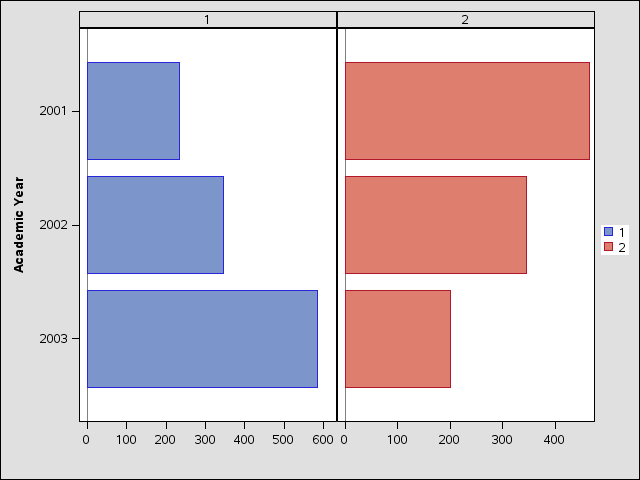- Home
- /
- Programming
- /
- Graphics
- /
- Descending Y Axis SGPanel with Hbar
- RSS Feed
- Mark Topic as New
- Mark Topic as Read
- Float this Topic for Current User
- Bookmark
- Subscribe
- Mute
- Printer Friendly Page
- Mark as New
- Bookmark
- Subscribe
- Mute
- RSS Feed
- Permalink
- Report Inappropriate Content
I found a number of examples online for sorting the y-axis using the word descending but not for sgpanel / vbar, hbar.
In some cases sorting the data first helped in others descending just needed to be used with the hbar line.
Can this be done?
My objective is
Year
2005 2004 2003 | 2005 bar group1 2004 bar group1 2003 bar group1
| 2005 bar group2 2004 bar group2 2003 bar group2
|
proc sort data=enrollment;
by descending FOUR_DIGIT_YEAR;
run;
proc sgpanel data=enrollment;
panelby residency_desc/ novarname uniscale=row layout=columnlattice;
hbar FOUR_DIGIT_YEAR / response=STUDENTS_ENROLLED stat=sum group=degree_level /*descending*/;
keylegend / position=right noborder;
run;
Accepted Solutions
- Mark as New
- Bookmark
- Subscribe
- Mute
- RSS Feed
- Permalink
- Report Inappropriate Content
Nevermind, I just saw in another of your posts that you are running SAS 9.2. I think the REVERSE option was added in SAS 9.3. As an alternative, if you presort *all* of the "class" variables in sgpanel, then SGPANEL will not auto sort the data. In addition, you'll need to tell the axis to stay in data order. The code will look something like this:
proc sort data=enrollment;
by residency_desc descending FOUR_DIGIT_YEAR;
run;
proc sgpanel data=enrollment;
panelby residency_desc/ novarname uniscale=row layout=columnlattice;
rowaxis discreteorder=data;
hbar FOUR_DIGIT_YEAR / response=STUDENTS_ENROLLED stat=sum group=degree_level /*descending*/;
keylegend / position=right noborder;
run;
- Mark as New
- Bookmark
- Subscribe
- Mute
- RSS Feed
- Permalink
- Report Inappropriate Content
Drop the PROC SORT and see if this works for you. If it doesn't, please post a picture of your current result:
proc sgpanel data=enrollment;
panelby residency_desc/ novarname uniscale=row layout=columnlattice;
hbar FOUR_DIGIT_YEAR / response=STUDENTS_ENROLLED stat=sum group=degree_level /*descending*/;
rowaxis reverse;
keylegend / position=right noborder;
run;
- Mark as New
- Bookmark
- Subscribe
- Mute
- RSS Feed
- Permalink
- Report Inappropriate Content
That should have been ROWAXIS, not YAXIS. I fixed the code.
- Mark as New
- Bookmark
- Subscribe
- Mute
- RSS Feed
- Permalink
- Report Inappropriate Content
When I use reverse I receive an error. It is not an option…
proc sql noprint;
CREATE TABLE enrollment (
FOUR_DIGIT_YEAR varchar(50),
STUDENTS_ENROLLED int,
residency_desc varchar(50)
);
/*panel one data*/
INSERT INTO enrollment
(FOUR_DIGIT_YEAR, STUDENTS_ENROLLED, residency_desc)
VALUES
('2001', 234, '1');
INSERT INTO enrollment
(FOUR_DIGIT_YEAR, STUDENTS_ENROLLED, residency_desc)
VALUES
('2002', 345, '1');
INSERT INTO enrollment
(FOUR_DIGIT_YEAR, STUDENTS_ENROLLED, residency_desc)
VALUES
('2003', 584, '1');
/*panel two data*/
INSERT INTO enrollment
(FOUR_DIGIT_YEAR, STUDENTS_ENROLLED, residency_desc)
VALUES
('2001', 465, '2');
INSERT INTO enrollment
(FOUR_DIGIT_YEAR, STUDENTS_ENROLLED, residency_desc)
VALUES
('2002', 344, '2');
INSERT INTO enrollment
(FOUR_DIGIT_YEAR, STUDENTS_ENROLLED, residency_desc)
VALUES
('2003', 200, '2');
quit;
proc sgpanel data=enrollment;
panelby residency_desc / novarname uniscale=row layout=columnlattice;
hbar FOUR_DIGIT_YEAR / response=STUDENTS_ENROLLED stat=sum group=residency_desc;
rowaxis label='Academic Year';
colaxis label=' ';
keylegend / position=right noborder;
run;

- Mark as New
- Bookmark
- Subscribe
- Mute
- RSS Feed
- Permalink
- Report Inappropriate Content
What version of SAS are you running?
- Mark as New
- Bookmark
- Subscribe
- Mute
- RSS Feed
- Permalink
- Report Inappropriate Content
9.2
- Mark as New
- Bookmark
- Subscribe
- Mute
- RSS Feed
- Permalink
- Report Inappropriate Content
Nevermind, I just saw in another of your posts that you are running SAS 9.2. I think the REVERSE option was added in SAS 9.3. As an alternative, if you presort *all* of the "class" variables in sgpanel, then SGPANEL will not auto sort the data. In addition, you'll need to tell the axis to stay in data order. The code will look something like this:
proc sort data=enrollment;
by residency_desc descending FOUR_DIGIT_YEAR;
run;
proc sgpanel data=enrollment;
panelby residency_desc/ novarname uniscale=row layout=columnlattice;
rowaxis discreteorder=data;
hbar FOUR_DIGIT_YEAR / response=STUDENTS_ENROLLED stat=sum group=degree_level /*descending*/;
keylegend / position=right noborder;
run;
- Mark as New
- Bookmark
- Subscribe
- Mute
- RSS Feed
- Permalink
- Report Inappropriate Content
It worked the key was the discreteorder=data.
April 27 – 30 | Gaylord Texan | Grapevine, Texas
Registration is open
Walk in ready to learn. Walk out ready to deliver. This is the data and AI conference you can't afford to miss.
Register now and lock in 2025 pricing—just $495!
Learn how use the CAT functions in SAS to join values from multiple variables into a single value.
Find more tutorials on the SAS Users YouTube channel.
SAS Training: Just a Click Away
Ready to level-up your skills? Choose your own adventure.



